Location: Lat:76 41.648 N Long: 170 27.27.949 W
Today's journal is a random collection of questions that my students submitted to the Ask the Team section. They were such great questions that I decided to group them and turn them into a journal entry. If you have other questions, please check out the "Ask the Team" section. If you don't see your question already posted, feel free to post a new question!
Thank, Cristina Galvan
Life on a ship: How do they get the helicopters in the hangar?
The helicopters land on a landing pad on the back deck of the boat. Then they get wheeled in and out of the hanger. They have to make sure to line up the propellers so that they can both fit in at the same time.
Why is there a basketball hoop in the hangar? Who plays?
Remember that the Coast Guard personnel are generally on the boat for several months at a time. The basketball hoop is there as a pass time activity. It's important to keep morale high since people can get bored easily being on the same ship with the same people for months at a time.
The Coast Guard also make sure to find other fun ways to pass the time - check out this artwork.
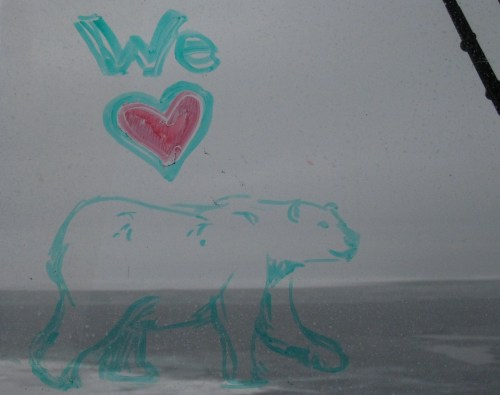
Are people allowed to drink alcohol on the ship?
Alcohol is not allowed on any US service ship - Coast Guard, Navy, etc.
Do you get claustrophobic on the ship? Not really. It's actually really big - it's 399 feet long and up to 78 feet wide at the widest part. There at least 6 levels (I haven't even been to all of them yet!). There are lots of little rooms that I am still discovering. Yesterday, I found the library - it has a comfy couch! I also just discovered the illusive Polar Tully's (the onboard coffee shop).

Whenever I am tired of being inside, I can always head outside for some fresh air. I just need to make sure to wear some warm clothes.
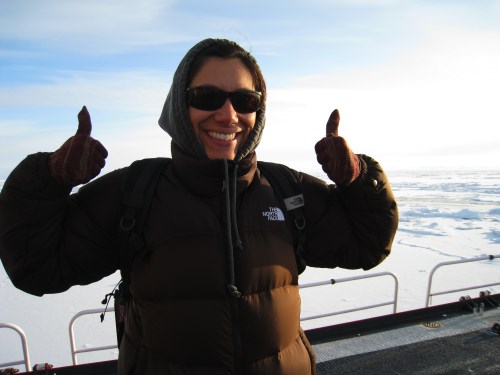
However, my bunk bed is a bit claustrophobic. I think there is about 2.5 feet between my bed and the bed above me. I'm just happy when I don't wake up and smack my head or knees on the bed!
Where does your drinking water come from?
There are two sources of water onboard the ship. The ship has storage for 26,586 gallons of water that it brought from Seattle. It also can make about 16,000 gallons of water a day from sea water using reverse osmosis. Now remember, this water has to be used by about 160 people for everything including drinking, cooking, cleaning, showers, laundry, etc.
Is the shower hot or cold?
The shower CAN be hot. Sometimes I struggle to figure out how to make it hot and I get stuck with cold water. But the boat can definitely heat the water. The showers have to be really short though!
How many scientists are on the boat?
There are about 25 people on the boat that are not crew - this includes scientists, photographers, helicopter pilots, and me.
How many people total are on the boat?
There are about 170 people on board.
Are the sleeping arrangements co-ed?
Nope. I have two female roommates and we share a bathroom with two other females.
Tell us about your roommates - what are they like and why are they on the boat?
I have two roommates. One is Dawn Sechler, a graduate student from Southern Illinois University. She is about to turn 25 - in fact her birthday will happen while on the boat! She is here to do a research project on chlorophyll in the sea water from different depths and exposed to different amounts of UV light. I'll review her project once it gets started.
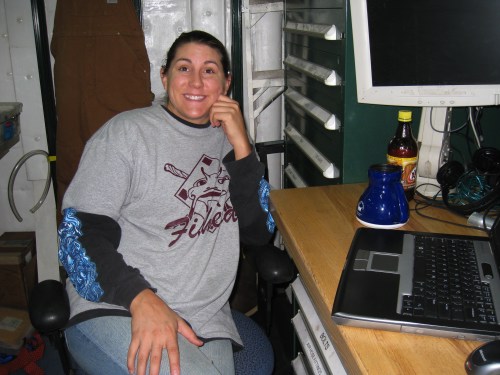
The other roommate is Brenna McConnell. She is also a graduate student, but with the University of Alaska at Fairbanks. She is part of the team of scientist researching microorganisms that might be living above and below the sea ice. She will be taking samples of ice from the top, while her colleagues dive underneath the ice to take samples from below.
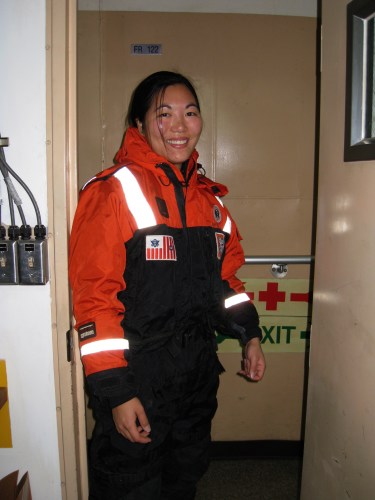
Why are they doing this polar bear research on a military ship?
Excellent question! The Coast Guard has three Polar Class Ice Breakers. These are mostly used for scientific research vessels. These types of ships are the only types that can actually get to the Polar regions for research. The Coast Guard works with the National Science Foundation to make these types of trips possible.
Polar Bear Project Can you send us some pictures of the tranquilizer gun you use on the polar bears?
Sure! However, it might take a day or two to get these pictures. Any type of gun has to be locked up in the Armory until it is needed. The next time the helicopter heads out, I'll make sure to do that for you.
What if the bears wake up while you are near them?
The drug that is used to tranquilize the bears is very gentle and very predictable. They make sure to give the bear enough tranquilizer to keep it asleep while they work on it. However, if the bear were to start to wake up while are still collecting data we would have signs - for example, the muscles get really stiff right before they start to wake up. If we needed more time, we would give them more tranquilizer.
Once they are done, the team does stay with the bear until it starts to wake up. They don't want to leave the bear while it's still vulnerable and can't defend itself against another bear.
Why do you need to collect polar bear feces? Are the feces frozen?
Great question! The thing with polar bear studies is that often scientist collaborate with each other since it is hard to get out and collect samples from bears. The feces are for another research team to use in their data. The USGS team collects data on every polar bear collected and archives it for long term studies. They make sure to collect fresh feces so it's not frozen.
How will you get the fat samples from the polar bears?
The fat samples are taken when they do a small surgery on the bear to take a muscle sample as well. The sample is taken from the back of the bear's thigh.
What percent of polar bears are male?
The population is pretty evenly split - 50% male, 50% female.
What do you mean you are taking milk samples from the polar bears...is it just the females? Do you milk them like a cow?
Yes, it is only the lactating females that we can collect milk samples from. Only females who have young cubs would be lactating. I asked the researchers and they said it IS sort of like milking a cow, but the milk is thicker than a cows milk and smells like seals. Sometimes, they have to give the bear a hormone called Oxytocin to stimulate the lactation.
Other Projects Why are the scientists in one of your pictures (Alex and Katie) looking out for birds and mammals? What are they studying?
Great question! They are doing a sample to determine the density of the organisms that live in a specific area. The Fish and Wildlife Service will use that data to help get an idea of what types of organisms are in a given location at different times of the year.
In the picture titled "Science in Action" (of the wetlab), what are in those jar-looking things? Are they filters?
Those jar looking things are indeed filters - great guess. The team from Southern Illinois University are using them to filter water samples from different depths. They are then taking the filters back to their lab to analyze for different substances. They are most interested in what is going on with the bottom of the food chain.
Here is the machine that is used to collect water samples from different depths. It is called a CTDA research tool that is submerged in the water to measure conductivity (salinity), temperature, and depth. device, which stands for Conductivity, Temperature and Depth.
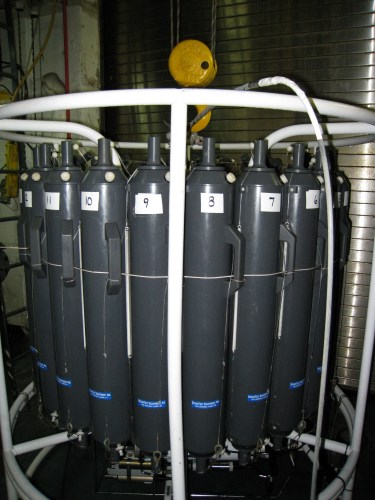
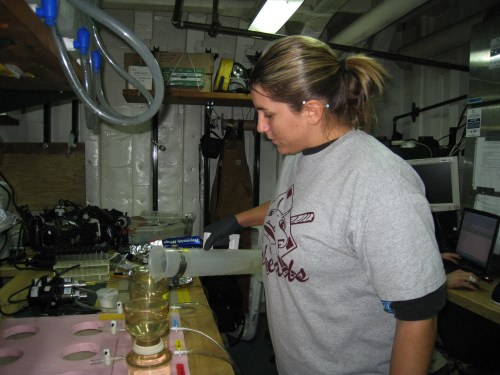
Can the divers feel the when they go into the sea, even though they're wearing special suits?
The divers wear wool and warm layers underneath of a special divers long underwear. On top of all of that, they wear a dry suit. The also wear warm socks and gloves underneath of booties for diving. However, despite all of that they still get cold and stay in the water for about 45 minutes. The part of their body that gets really cold is their faces. Their faces are not covered at all and their lips get numb - sort of like when you go to the dentist.
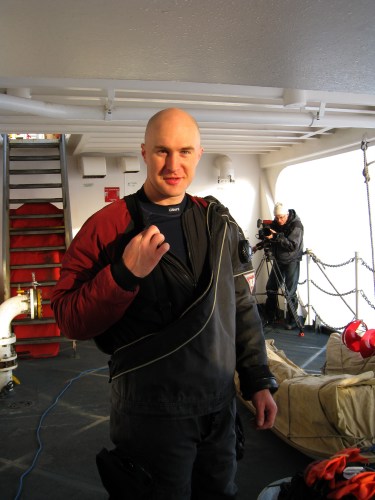
Other How cold is the water over there? It depends on where we are in the ocean. Currently, the water temperature is 36 F, but the range we have seen so far is from 35 F to 42 F.
Are you tired of being on the ship? No! There is still so much to see and do. There are three other experiments happening. There are so many parts to how the ship works. There is a lot that I am still looking forward to. For example, the ship has yet to go through really thick ice. I am really excited to see how the ship does that.
There are also lots of activities on board the ship for the Coast Guard. For example, sitting in on an Earth Science lab or watching the Tin Can Challenge.
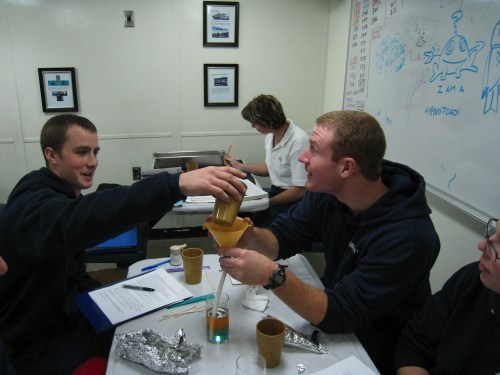
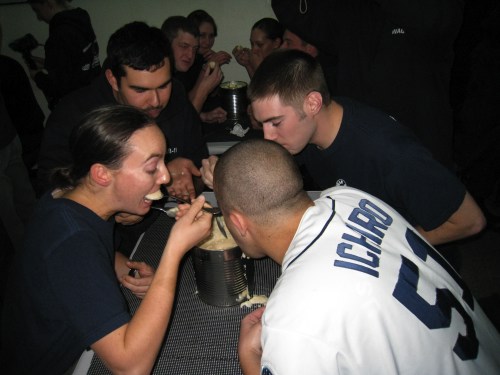
How far does the sea ice go down under the water? Is it 75% under water like regular ice? Great question! The depth of the sea ice depends on how cold it is and how long its been there. Multiyear ice (ice that has survived more than one year without melting) is blue in color and currently is thicker than the other pieces of newly formed ice. The ice we are in right now is only about 4 inches thick, but hopefully we will soon find deeper ice. The ice diving team needs ice that is at least 1 foot thick so it is safe to walk on. The helicopters need hard, dry ice that is about 6 inches thick to land on.
Why is the day(light) so short up there? Oh great question! Well, really it's the same reason why the days get shorter in the winter where you are and longer in the summer. I have a hard time explaining this one without a good drawing, but have found a good website with some nice drawings to help explain.
Here's a brief explanation - As the Earth orbits the sun, it has a slight tilt. During the winter time, the Northern hemisphere tilts away from the sun so the light doesn't reach the far north parts for very much time of the day. Imagine a flashlight and ball, the flashlight doesn't light up the backside of the ball. If you tilt the ball, then the top part of the ball also doesn't get lit up. In the summer, the opposite is true. The tilt of the Earth is towards the sun, so that the Northern part is constantly lit and you get 24 hours of sunlight.
Is the North Pole colder than the South Pole?
Actually, the South Pole gets much colder that the North Pole.
However, I challenge you to find out the coldest recorded temperature for each location. In fact, if you are the first one to email me the coldest recorded temperature for North and South Pole AND can state WHY they are different - I'll bring you an Arctic treat! (here's the address to reach me at - cristinagalvan [at] polarsea.polarscience.net)
And sorry, this challenge only applies to my students! I can't bring
Arctic treats to everyone 


Comments